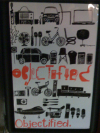Last night Wen & I went and saw Objectified, Gary Hustwit's new movie documenting how the best designers in the world create new, desirable objects.
He's interviewed the leading luminaries in the business - Jonathan Ives, Dieter Rams, Karim Rashid, Naoto Fukasawa, everybody at Ideo, Marc Newson, the Bouroullec brothers, etc. - and they shed their thoughts on how it's done.
It's an illuminating story - one of the most memorable scenes is Fukasawa describing how he created a phone to have faceted faces so that you'd want to touch it. He talks about how we subconsciously play with the phones in our pockets - and he wanted to create a phone that would encourage you to do this without thinking. His philosophy is that great "design dissolves into behaviour."
The movie is great, although it occasionally feels like some of the designers are great posers. Some credibly talk about the philosophy of how they create objects (notably Fukusawa, Ives, Rams and Rashid), with an emphasis on solving people's problems with the simplest of designs. However, some of the other designers let slip that "we just threw the buttons on it" or something similar, undermining the attempts of their peers to demonstrate that there might be a science behind their art.
The other unnerving element of the movie comes when Paolo Antonelli suggests that she would like to see designers as the new intellectuals consulted by government whenever there is a public policy issue. Something about this just doesn't feel right, and it is demonstrated by a scene where a bunch of Ideo staffers try to re-imagine the toothbrush. The team spends a few days trying to imagine the future of oral care and create a toothbrush with a lower environmental impact. The result of the drill is a new toothbrush with a replaceable head: a product that will almost certainly never make it to market.
It won't make it to market, not because it's a bad product, but because it does not recognize that reducing the environmental impact of a toothbrush isn't just about building a better product. It's about consumer behaviour: how do you change user's behaviour when the current toothbrush satisfices; it's about supply chains: how do you sell this product and get it distributed. The overwhelming sense was that these designers don't scale: they can create beautiful products but when it came to addressing world-changing issues, they naively assume that a perfect product will sell itself (if the history of the computer industry has taught us nothing else, it's that better products alone do not suffice - check out the Mac and the Xerox Alto).
Despite this, I highly recommend seeing the movie as it is entertaining and engaging. Also, if you live in NYC, a lot of the stock footage is shot here and it's alway fun to see your city in a new light.